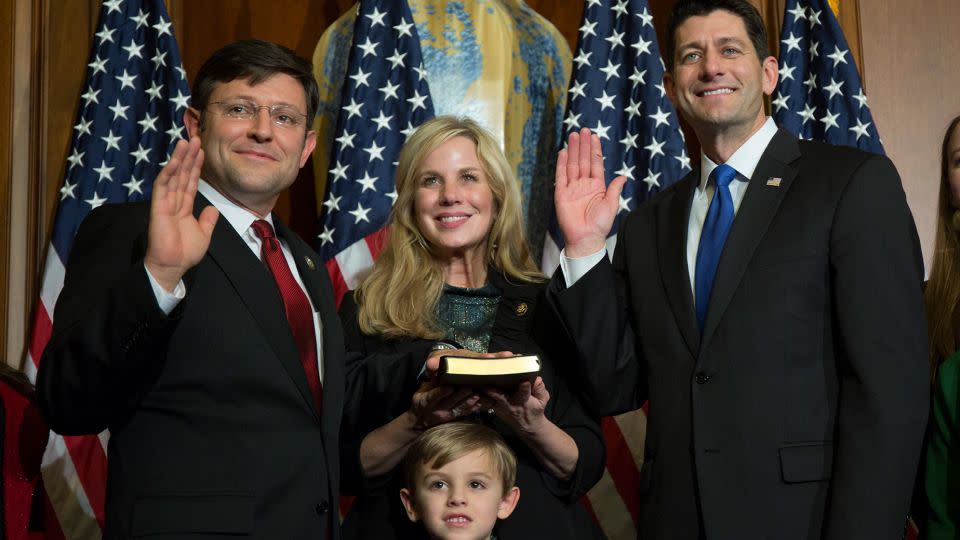What is no-fault divorce, and why do some conservatives want to get rid of it?
Following what some conservatives view as legal victories on the battlegrounds of abortion rights and affirmative action, a number of politicians and influencers are turning their attention to another long-held construct: No-fault divorce.
Right-wing commentators like Steven Crowder and Matt Walsh have ramped up complaints in recent months that it is too easy for people — specifically women — to get divorces. All states currently have some version of a no-fault divorce law, but Republicans in Texas and Nebraska list the dissolution or restriction of no-fault divorce in their state party political platforms.
In Louisiana earlier this year, state GOP members debated officially backing the dissolution of no-fault divorce, but no decision was made. A lack of full-on legislative attempts to curb the practice hasn’t stopped an abundance of conservative anti-divorce rhetoric, or an answering wave of fear from progressives.
Newly minted House Speaker Mike Johnson has been a vocal opponent of no-fault divorce, which allows couples to obtain a divorce without proving fault — and without both parties agreeing to the split. In a 2016 sermon, he claimed it turned the United States into a “completely amoral society.”
Though no-fault divorce was first legalized more than 50 years ago, it has long been sneered at in conservative circles, who see it as a danger to the sanctity of marriage and the concept of the American family.
For feminists, human rights advocates and others, no-fault divorce is an important buttress for gender equality and directly addresses issues like marital abuse. Many legal minds also see no-fault divorce as a common-sense legal path that reduces unnecessary burdens on courts and couples alike.
It may not seem political on its surface, but the history of no-fault divorce in the US reveals a clear connection to these social issues and outlines why some feel so strongly about protecting it while others seek to tear it down.
What is no-fault divorce?
No-fault divorce is, as it sounds, a divorce that can be obtained without anyone having to allege or prove that one party’s behavior is to blame. A majority of states also allow fault divorce, where one party can claim reasons like adultery, abandonment, long-term incarceration or cruelty.
“Cruelty – and more specifically, causing a spouse unneeded pain, whether emotional or physical — is typically the most common grounds for a fault divorce.,” says Thomas A. Ramuda Jr., a divorce attorney based in Colorado. “Many no-fault divorces are obtained on the grounds of “irreconcilable differences.”
From a legal standpoint, no-fault divorce cases tend to be less complex. “When one party alleges another is at fault, they have to prove it in court. Proving fault can also affect the outcome of a divorce in terms of custody or visitation arrangements,” Ramuda said.
What is the history of no-fault divorce in the US?
No-fault divorce was first legalized in California in 1969 by then-Governor Ronald Reagan, who would eventually become the first US president who had been divorced (Former President Donald Trump was the second.) By 2010, every state had legalized a no-fault divorce option.
Before this option, an at-fault divorce was the only recourse for a broken union. This led to complications for couples whose situation, for one reason or another, didn’t fit the required legal procedure.
Couples who wanted a divorce were all but forced by the law to create some sort of fault-based scenario. It wasn’t uncommon for couples to concoct scenarios together that would feign adultery, or for one party to move across state lines to fulfill legal requirements for fault claims like abandonment. Migratory divorce, where a couple would move together to a state with no-fault divorce laws, was common.
In fact, these methods were so widespread that, to a lot of legal experts, a solution like no-fault divorce was necessary to make the system work again. The National Association of Women Lawyers championed no-fault divorce solutions throughout the first half of the 20th century.
In 1961, prominent NAWL member Matilda Fenberg explained the reasoning behind the group’s own proposed no-fault divorce bill and called current divorce laws “impractical and unsound.”
“The purpose of our Bill is not to make divorce easier or more difficult,” Fenberg wrote in the group’s proposal for a Uniform Divorce Bill. “It is simply to substitute truth for deception, common sense for technicalities, and to give the Courts real opportunity to prevent marriage failures by means of conciliation and treatment, rather than to punish failures in marriages.”
Though the NAWL’s no-fault divorce efforts did not directly bear fruit, their activism also underscored the particular interest women had in divorce law reformation.

While no-fault divorce is common now, it’s most visible among high-profile couples when a go-to no-fault phrase like “irreconcilable differences” hits the headlines. When Bill and Melinda Gates divorced in 2021, legal documents stated the marriage was “irretrievably broken;” a variation on the no-fault theme.
Some of the shortest celebrity marriages, like the 72-day union of Kim Kardashian and Kris Humphries in 2011, ended with “irreconcilable differences” (though, in this case, Humphries claimed the marriage was fraudulent, and the divorce dragged out for nearly two years.)
Gwyneth Paltrow and husband Chris Martin put a famous spin on no-fault language with their 2014 divorce announcement, saying they intended to “consciously uncouple.” (Legal documents filed by Paltrow did, indeed, name “irreconcilable differences.)
What benefits do people claim no-fault divorce provides?
In the simplest terms, no-fault divorce provides an easier path to ending a marriage. Depending on their situation, couples can avoid expensive and protracted litigation, as well as the damaging effects of having to cast, prove or defend from blame.
Paulette Rigo, a mediator and certified divorce coach who started The Better Divorce Academy after her own difficult split, says couples sometimes don’t realize there are options for divorce outside of ugly legal battles.
“The legal process is adversarial,” she told CNN. “You have a plaintiff, a defendant. You have to spend hundreds of dollars an hour on an attorney. And that seems silly if both people in the relationship want the same thing. Of course, there are cases that require litigation, but the idea that it has to be that way can be even more destructive for families during a difficult time.”
Rigo also said no-fault divorces can also be easier on children, who are affected by financial decisions and family environment provided by their parents.
Women’s rights groups count no-fault divorce law as a way to make marriage — an institution that has long provided the most material benefit for the husband — more equitable for women.
Before no-fault divorce, a woman in the US who was in an abusive or exploitative marriage didn’t have many options. Husbands typically controlled a family’s finances, and the social stigma for seeking divorce — not to mention the difficult process of having to prove “fault” — was a major deterrent. These problems got more complicated if a husband didn’t want a divorce.
“Under US laws, every person has a right to divorce, even if your spouse says no,” said Rigo.
Since 1969, studies have shown no-fault divorce correlates with a reduction in female suicides and a reduction in intimate partner violence. A 2004 paper by economists Betsey Stevenson and Justin Wolvers found an 8 to 16% decrease in female suicides after states enacted no-fault divorce laws. They also noted a roughly 30% decrease in intimate partner violence among both women and men, and a 10% drop in women murdered by their partners.
“Unilateral divorce both potentially increases the likelihood that a domestic violence relationship ends and acts to transfer bargaining power toward the abused,” the study states.

Why do some people want to get rid of no-fault divorce?
Conservative politicians and commentators, along with some religious and social groups, say unilateral divorce degrades the American family unit and adversely affects men, children, and the economy.
“Unilateral no-fault divorce clearly violates the 14th Amendment,” Beverly Willet, co-chair of the Coalition For Divorce Reform claimed earlier this year in the Washington Examiner. “Too often in family court, defendants are deprived of life, liberty, and property without due process of law.”
Some conservative Christians in particular have fought against no-fault divorce because they believe that divorce is unbiblical and marriage ordained by God.
Speaker Johnson, who has voiced opposition to no-fault divorce, has also extolled the virtues of what is called a “covenant marriage,” a religiously influenced marriage option in some states which makes divorce extremely difficult.
Covenant marriages are only legally recognized as an option in Arizona, Arkansas and Louisiana, where Johnson and his wife entered their own covenant marriage. Such unions, modeled after the covenants of religious covenants, can only be broken for specific reasons like adultery or physical abuse, not unlike the contours of at-fault divorces.
CNN has reached out to Johnson’s office via phone and email for comment.
Statistics show no-fault divorce does indeed correlate with an initial spike in divorce rates, but the numbers even out or even drop below previous rates over time. Census data from 2020 revealed the US divorce rate hit a 50-year low in 2019.
Research does not strongly support the popular conservative claim that separation adversely affects children in a way that staying in a bad marriage would not.
A 2019 study published in World Psychology found that while children of divorced couples may struggle with some negative repercussions, “most children whose parents divorce are resilient and exhibit no obvious psychological problems.”
The study adds that there are innumerable other factors that could affect a child of divorce’s wellbeing that have nothing to do with the divorce itself.
“Marital instability presents not a single risk factor, but a cascade of sequelae for children,” the study reads.
This conclusion hints at the shape of another quandary at the center of the no-fault divorce debate, and public feelings on divorce in general: Whether divorce itself is a problem, or if it’s a symptom of larger issues within the institution of American marriage.
For more CNN news and newsletters create an account at CNN.com

